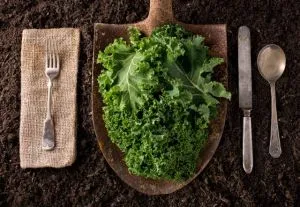Kale is one of those versatile foods that can be prepared and eaten in a number of ways. While it is a standard staple in many health-conscious diets, there are some things about kale that may surprise you.
1. Low calories / high nutrition
A one-cup serving of kale may only have 33 calories, but it also contains a whopping 206 percent of your daily recommendation of vitamin A, a 134 percent of your daily recommendation of vitamin C, and 684 percent of your daily vitamin K.
Kale also provides a healthy dose of folate, iron, omega-3s, fiber, protein, and magnesium.
2. Culinary flexibility
This delightful vegetable can be prepared in a variety of ways. Kale is delicious when chopped up into a salad, blended up into a smoothie, squeezed into a tasty juice, baked into a crisp chip, and even added into a cocktail drink.
3. Great source of calcium
A cup of milk contains approximately 96 milligrams of absorbable calcium, whereas one cup of raw kale contains 83 milligrams of absorbable calcium. Since calcium is so important to the formation and maintenance of healthy teeth and bones, kale is an important dietary source that should not be overlooked.
4. Price is right
At an average price of two to three dollars for a bag of organic leaves, this superfood is definitely more affordable than most of its fellow vegetables. It is always best to buy kale organic whenever possible, as non-organic kale is on the Environmental Working Group’s “Dirty Dozen” list for higher exposure to pesticides.
5. National Kale Day
Kale contains such a bountiful mixture of health benefits and nutritional goodness that it has a day specifically dedicated to it. On October 1st, kale is celebrated for the great impact it can make on our bodies and our palates.
6. Superpowers
Kale contains a powerful punch of phytonutrients that can help reverse inflammation and boost the detoxification abilities of the liver. Starting off each day by drinking a green kale smoothie is a great way to start a simple detox.
7. Many varieties
Kale comes in many tasty varieties, and they are all worth checking out. You can mix up more than one for a combination of delicious flavors and textures. Try one or more of the following: dino kale, redbor kale, Siberian kale, premiere kale, kamome red kale, red Russian kale, and walking-stick kale.
8. Easy to grow your own
Kale can grow in practically any climate, but it is particularly partial to cold weather. The temperature, soil conditions, and weather patterns all play a large role in determining the flavor, output and harvesting time.
Kale can easily tolerate temperatures down to 20 degrees F, but it begins to turn bitter and toughen up when temperatures rise above 80 degrees F.
9. There is a toolkit
Kale is so awesome that those in the know put together a “Kale Hero Toolkit” to help any kale beginners with experiments, recipes, and more. It is available for download at NationalKaleDay.org.
10. Raw or cooked
The cooking process does release some of the nutrients in kale, such as magnesium. However, it can also decrease the amounts of some other nutrients, like folate, which is heat sensitive. To get the maximum amount of nutrition, work both raw and cooked kale into your meals.
11. Not a cause of hypothyroidism
Despite reports around the internet linking kale to hypothyroidism, there is no scientific research to support this claim. According to Dr. Drew Ramsey:

12. A couple words of caution
Although it is very rare to have an allergy to cruciferous vegetables, it is possible. Also, anyone taking blood thinners may need to avoid kale because the vitamin K could interfere with medicines like Coumadin.
If you are on medication, or have any reservations about adding kale to your diet, it may help to talk to a health professional you trust. Otherwise, go ahead and board the kale train – you’ll be well on your way to great health!
-The Alternative Daily
Sources:
http://foodmatters.tv/content/17-fun-facts-about-kale
http://www.huffingtonpost.com/2013/07/30/kale-facts-nutrition-info_n_3671210.html
http://www.collective-evolution.com/2014/10/05/15-things-everyone-should-know-about-kale
http://nationalkaleday.org
